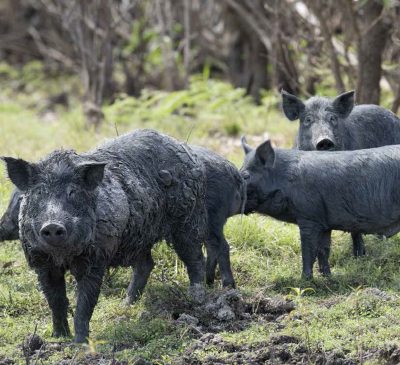Experts say further research is needed to understand the potential role Australia’s large feral pig population could play in spreading a disease such as Foot and Mouth Disease if an outbreak occurs here.
 Feral pigs already cause extensive damage to crops, livestock and other agricultural sectors across Australia on a massive scale, costing the economy at least $100 million every year.
Feral pigs already cause extensive damage to crops, livestock and other agricultural sectors across Australia on a massive scale, costing the economy at least $100 million every year.
They also can be potential vectors for disease.
In many parts of the world, wild or feral pigs have been shown to be involved in the spread of African swine fever. In 2019, African swine fever was detected in Timor Leste and then Papua New Guinea in 2020.
These events contributed to the many reasons why a National Feral Pig Action Plan was created during 2020 and launched in 2021.
Risk can’t be dismissed
Existing research suggests feral pigs are unlikely to play a significant role in the epidemiology of FMD in Australia, National Feral Pig Management Co-ordinator, Dr Heather Channon said in response to questions from Beef Central.
Climatic conditions, the capacity of the virus to survive outside the host for extended periods and the density and size of feral pig populations all make it unlikely that they will be involved in the maintenance of a reservoir of FMD infection.
However, they are still a potential risk that can’t be completely dismissed, Dr Channon said.
What the research says
A 2011 study by Mohamed et al showed that under experimental conditions, serotype A could be transmitted from domestic pigs to feral pigs and vice versa. A study published by the European Food Safety Authority in 2012 concluded that transmission from wildlife to domestic animals can occur, so wildlife can play a role in the spread of FMD.
However, Dr Channon points out that experimental evidence does not prove the potential for virus transmission when the prevalence of disease and proximity of infected animals may be much lower in a natural setting.
Australia’s AUSVETPLAN states that for FMD, one of the most contagious animal diseases, movement of infected animals is one of the most important routes of spread between herds and farms. Transmission occurs most readily when animals are in close proximity, such as at watering and feeding points, and congregation points such as stockyards and milking sheds.
AUSVETPLAN cites evidence to show that experience to date with FMD in tropical countries suggests that spread from cattle and buffalo to pigs during casual contact is rare.
European studies show that while infection may spread to wild boar, wildlife populations were not able to maintain infection.
Deer, for example, do not appear to influence the spread of FMD in wildlife. Studies of South American outbreaks show the feral pigs haven’t played a role in the spread of the disease.
Potential of feral pigs to spread disease in Australia
Accordingly, Dr Channon said, the potential of feral pigs in Australia to spread FMD will be dependent on factors including host abundance, contact rates, habitat suitability and climatic factors. “
With the National Feral Pig Action Plan now in place, we aim to achieve sustained reductions in feral pig impacts by supporting land managers with applying combinations of humane, best practice management techniques to effectively control feral pig populations and reduce their impacts,” Dr Channon said.
“This means encouraging people to work together with others (rather than individually) and to provide the tools, technologies, resources and training needed to support their on-ground actions.
She added that entry, spread and maintenance of FMD in feral animal populations will be subject to ongoing risk assessment to ensure that feral animals are fully considered in the design of the eradication program.
Risk mitigation programs will be implemented in feral animal populations that are assessed to pose an unacceptable risk. Assessment will require information about:
- density and distribution of the animals
- social organisation, including home ranges
- habitat
- contact with domestic species
- strain of FMDV
- length of time feral animals could have been exposed to the virus
- potential exposure of feral animals to risk materials, such as at landfill sites, in paddocks on which milk has been sprayed, or in areas used for composting.
This information will help to determine the level of measures to be applied, including:
- containment
- tracing and surveillance
- population reduction
- restrictions on hunters so that feral pig populations are not further dispersed.
In Indonesia now, the rapid spread of FMD is most likely associated with movement and trade of infected farmed animals, Dr Channon said.
The re-emergence of FMD in Indonesia demanded that Australian land managers are vigilant with on-farm biosecurity practices, be on the lookout for signs of FMD and contact the national Emergency Animal Disease Watch Hotline on 1800 675 888 to report any animals behaving abnormally, or with symptoms of FMD.
